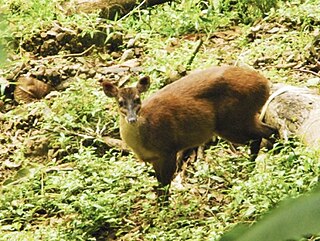 W
WThe Central American red brocket is a species of brocket deer ranging from southern Mexico, through Central America, to northwestern Colombia. It was formerly treated as a subspecies of the red brocket from South America, but its karyotype has 2n = 50, while the latter's was initially described as having 2n = 68–70. However, a more recent description gives the red brocket a variable karyotype with 2n ranging from 48 to 54, suggesting it represents several species. It is sympatric with the Yucatan brown brocket over part of its range. Additionally, it was estimated that the Mazama temama diverged from other red brocket deer about 2 MYA. This was estimated through analysis of concatenated sequences from the mitochondrial gene ND2, Cytb, and tRNA-Pro-Control region. The species is found in primary and secondary tropical forest at altitudes from sea level to 2800 m. In Mexico, it is regarded as an agricultural pest by bean farmers. It is probably threatened by hunting and deforestation.
 W
WThe white-tailed deer, also known as the whitetail or Virginia deer, is a medium-sized deer native to North America, Central America, Ecuador, and South America as far south as Peru and Bolivia. It has also been introduced to New Zealand, all the Greater Antilles in the Caribbean, and some countries in Europe, such as the Czech Republic, Finland, Romania, Serbia, Germany, and France. In the Americas, it is the most widely distributed wild ungulate.
 W
WA peccary is a medium-sized pig-like hoofed mammal of the family Tayassuidae. They are found throughout Central and South America and in the southwestern area of North America. They usually measure between 90 and 130 cm in length, and a full-grown adult usually weighs about 20 to 40 kg.
 W
WThe collared peccary is a species of mammal in the family Tayassuidae found in North, Central, and South America. They are commonly referred to as javelina, saíno, or báquiro, although these terms are also used to describe other species in the family. The species is also known as the musk hog. In Trinidad, it is colloquially known as quenk.
 W
WThe white-lipped peccary is a peccary found in Central and South America. Most of its range is in rainforests, but it is also known from a wide range of other habitats such as dry forests, grasslands, mangrove, Cerrado, and dry xerophytic areas. It lives in herds of 20–300 individuals that typically take up about 120 km2 (46 sq mi) to fully function. Members of this species are omnivorous, feeding mostly on fruit, and are usually found traveling great distances to obtain it. If this resource is in demand and difficult to find, peccaries eat leaves, stems, or animal parts. White-lipped peccaries have several unique attributes that allow them to stay with and identify their herd, which is essential for their survival in the wild.
 W
WBaird's tapir, also known as the Central American tapir, is a species of tapir native to Mexico, Central America and northwestern South America. It is one of three Latin American species of tapir.
 W
WThe West Indian manatee or "sea cow", also known as North American manatee, is the largest surviving member of the aquatic mammal order Sirenia. It is further divided into two subspecies, the Florida manatee and the Antillean or Caribbean manatee, based on genetic and morphological studies. The Florida subspecies is primarily found along the coasts of Florida, but its range extends as far west as Texas and as far north as Massachusetts. The Antillean subspecies has a sparse distribution throughout the Caribbean, ranging as far north as Mexico and as far south as Brazil.
 W
WThe Yucatan brown brocket is a small species of deer native to the Yucatán Peninsula of Mexico, Belize and Guatemala. While it is found in humid tropical forest like most other brocket deer, the Yucatan brown brocket also ranges across arid, relatively open habitats. It has been treated as a disjunct subspecies of the gray brocket or a subspecies of the red brocket.